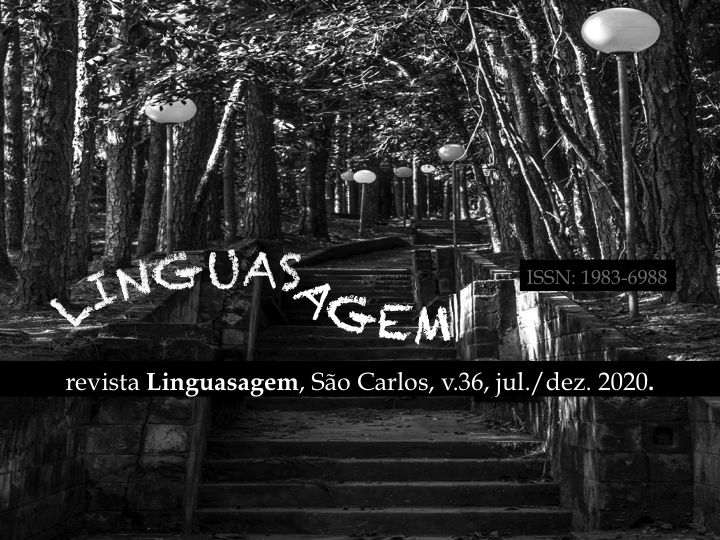CORPUS, CLASSES E COLETÂNEAS EM ANÁLISE DA CONVERSAÇÃO
Resumo
Os últimos vinte anos presenciaram o surgimento de uma forte convergência entre uma abordagem aplicada dedicada à criação de grandes corpora, sua codificação e rotulagem, e diversas teorias linguísticas cujas análises são baseadas em tais corpora. Para a análise da conversação (ou linguística interacional) tal convergência não parece possível, pois sua abordagem é qualitativa e se apoia em “pequenos” corpora. Além disso, é necessário um exame minucioso do contexto social das interações coletadas, o que não pode, portanto, ser reduzido à coleta de metadados. Uma questão surge imediatamente: a noção de um “pequeno” corpus tem validade no plano epistemológico? Este artigo mostra que uma resposta positiva pode ser dada a essa pergunta e que é possível fundamentá-la em razão de uma prática que, na maioria das vezes, está envolta em falsas evidências.
Referências
CLAYMAN S. E., GILL V. T. (2004). « Conversation analysis », in M. Hardy et A. Bryman (éd.) Handbook of data analysis. SAGE Publications, 589-606.
DURANTI A., GOODWIN C. (1992). « Rethinking context : an introduction », in A. Duranti et C. Goodwin (éd.) Rethinking context : Language as an interactive phenomenon. Cambridge : Cambridge University Press, 1-42.
FACHINETTI R. (éd.) (2007). Corpus Linguistics 25 years on. Amsterdam : Rodopi.
FORNEL M. de (1990) « Sémantique du prototype et analyse de conversation », Cahiers de linguistique française 11 : 159-178.
FORNEL M. de (1994). « Faire parler les objets : perception, manipulation et qualitification des objets dans l’enquête policière », in B. Conein et al. (éd.) Les objets dans l’action, De la maison au laboratoire, coll. « Raisons pratiques » 4 : 241-265.
FORNEL M. de, LÉON J. (2000). « L’analyse de conversation, de l’ethnométhodologie à la linguistique interactionnelle », Histoire Épistémologie Langage 22 (I) : 131-155.
FORNEL M. de, VERDIER M. (2014). Aux prises avec la douleur – Analyse conversationnelle des consultations d’analgésie. Paris : Éditions de l’EHESS, coll. « Cas de figure ».
GEERTZ C. (1998). « La description dense – Vers une théorie interprétative de la culture », Enquête 6 : 73-105.
GOODWIN C. (1984) « Notes on story structure and the organization of participation », in J. Maxwell Atkinson et J. Heritage (éd.) Structures of social action : Studies in Conversation Analysis. London : Cambridge University Press, 225-246.
GOODWIN M.H. (1980). « Processes of mutual monitoring implicated in the production of description sequences », Sociological Inquiry 50 : 303-317.
HERITAGE J. (1984). Garfinkel and ethnomethodology. Cambridge : Polity Press, 242.
Heritage J. (1998). « Oh-prefaced responses to inquiry », Language in Society 27(3) : 291-334.
HERITAGE J, RAYMOND G (2012). « Navigating epistemic landscapes : Acquiescence, agency and resistance in responses to polar questions », in J.P. De Ruiter (éd.) Questions : Formal, Functional and Interactional Perspectives. Cambridge : Cambridge University Press.
JEFFERSON G., LEE J. (1981). « The rejection of advice : managing the problematic convergence of a ‘troubles-telling’ and a ‘service encounter’ », Journal of Pragmatics 5 : 399-422.
MAYNARD D. W. (1997). « The news delivery sequence : Bad news and good news in conversational interaction », Research on language in social interaction 30(2) : 93-130.
MONDADA L. (2008). « L’analyse de “collections” de phénomènes multimodaux en linguistique interactionnelle : À propos de l’organisation systématique des ressources gestuelles en début de tour », Cahiers de praxématique 50 : 21-66.
POMERANTZ A. (1984). « Agreeing and disagreeing with assessments : some features of preferred and dispreferred turn shapes », in J.M. Atkinson et J. Heritage (éd.) Structures of social action, 57-101.
RAYMOND G. (2003). « Grammar and social organization : Yes/No interrogatives and the structure of responding », American Sociological Review 68 : 939-967.
SACKS H. (1992). Lectures on Conversation. Oxford : Basil Blackwell.
SACKS H., SCHEGLOFF E. (1973). « Opening up closings », Semiotica 4-13 : 69-99.
SACKS H., SCHEGLOFF E., Jefferson G. (1974). « A Simplest Systematics for the Organization of Turntaking in Conversation », Language 50 : 696-735.
SCHEGLOFF E. (1968). « Sequencing in Conversational Openings », American Anthropologist 70(6) : 1075-1095.
SCHEGLOFF E. (1987). « Analyzing single episode of conversation : an exercice in conversation analysis », Social Psychology Quarterly 50 : 101-114.
SCHEGLOFF E. (1992). « Repair After Next Turn : The Last Structurally Provided Defense of Intersubjectivity in Conversation », American Journal of Sociology 97(5) : 1295-1345.
SCHEGLOFF E. (1993). « Reflections on Quantification in the Study of Conversation », Research on Language and Social Interaction 26/1 : 99-128.
SCHEGLOFF E. (1996). « Confirming Allusions : Toward an Empirical Account of Action », American Journal of Sociology 102(1) : 161-216.
SCHEGLOFF E. (2000). « On Granularity », Annual Review of Sociology 26 : 715-720.
SIDNELL J. (2013). « Basic conversation analytic methods », in J. Sidnell et T. Stivers, The Handbook of Conversation Analysis. Blackwell Publishing Ltd, 77-99.
WHALEN J., ZIMMERMAN D. H., WHALEN M. R. (1988). « When words fail : a single case analysis », Social Problems 35 : 335-362.





